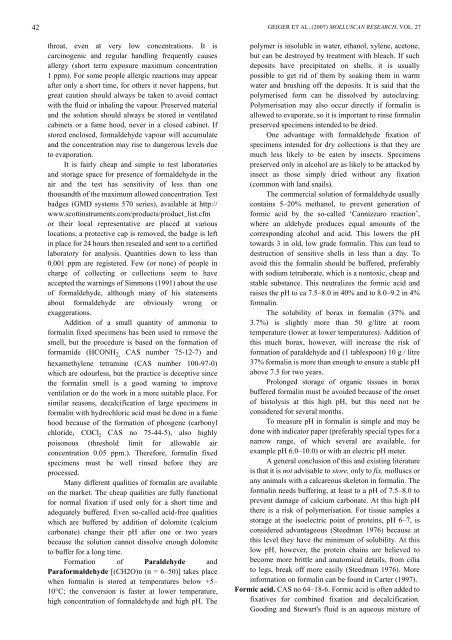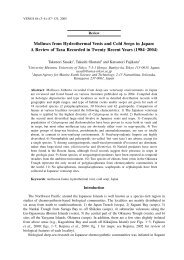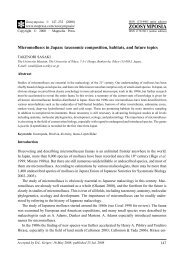Molluscan Research: Techniques for collecting, handling, preparing ...
Molluscan Research: Techniques for collecting, handling, preparing ...
Molluscan Research: Techniques for collecting, handling, preparing ...
Create successful ePaper yourself
Turn your PDF publications into a flip-book with our unique Google optimized e-Paper software.
42<br />
GEIGER ET AL. (2007) MOLLUSCAN RESEARCH, VOL. 27<br />
throat, even at very low concentrations. It is<br />
carcinogenic and regular <strong>handling</strong> frequently causes<br />
allergy (short term exposure maximum concentration<br />
1 ppm). For some people allergic reactions may appear<br />
after only a short time, <strong>for</strong> others it never happens, but<br />
great caution should always be taken to avoid contact<br />
with the fluid or inhaling the vapour. Preserved material<br />
and the solution should always be stored in ventilated<br />
cabinets or a fume hood, never in a closed cabinet. If<br />
stored enclosed, <strong>for</strong>maldehyde vapour will accumulate<br />
and the concentration may rise to dangerous levels due<br />
to evaporation.<br />
It is fairly cheap and simple to test laboratories<br />
and storage space <strong>for</strong> presence of <strong>for</strong>maldehyde in the<br />
air and the test has sensitivity of less than one<br />
thousandth of the maximum allowed concentration. Test<br />
badges (GMD systems 570 series), available at http://<br />
www.scottinstruments.com/products/product_list.cfm<br />
or their local representative are placed at various<br />
locations, a protective cap is removed, the badge is left<br />
in place <strong>for</strong> 24 hours then resealed and sent to a certified<br />
laboratory <strong>for</strong> analysis. Quantities down to less than<br />
0.001 ppm are registered. Few (or none) of people in<br />
charge of <strong>collecting</strong> or collections seem to have<br />
accepted the warnings of Simmons (1991) about the use<br />
of <strong>for</strong>maldehyde, although many of his statements<br />
about <strong>for</strong>maldehyde are obviously wrong or<br />
exaggerations.<br />
Addition of a small quantity of ammonia to<br />
<strong>for</strong>malin fixed specimens has been used to remove the<br />
smell, but the procedure is based on the <strong>for</strong>mation of<br />
<strong>for</strong>mamide (HCONH 2, CAS number 75-12-7) and<br />
hexamethylene tetramine (CAS number 100-97-0)<br />
which are odourless, but the practice is deceptive since<br />
the <strong>for</strong>malin smell is a good warning to improve<br />
ventilation or do the work in a more suitable place. For<br />
similar reasons, decalcification of large specimens in<br />
<strong>for</strong>malin with hydrochloric acid must be done in a fume<br />
hood because of the <strong>for</strong>mation of phosgene (carbonyl<br />
chloride, COCl 2 CAS no 75-44-5), also highly<br />
poisonous (threshold limit <strong>for</strong> allowable air<br />
concentration 0.05 ppm.). There<strong>for</strong>e, <strong>for</strong>malin fixed<br />
specimens must be well rinsed be<strong>for</strong>e they are<br />
processed.<br />
Many different qualities of <strong>for</strong>malin are available<br />
on the market. The cheap qualities are fully functional<br />
<strong>for</strong> normal fixation if used only <strong>for</strong> a short time and<br />
adequately buffered. Even so-called acid-free qualities<br />
which are buffered by addition of dolomite (calcium<br />
carbonate) change their pH after one or two years<br />
because the solution cannot dissolve enough dolomite<br />
to buffer <strong>for</strong> a long time.<br />
Formation of Paraldehyde and<br />
Para<strong>for</strong>maldehyde [(CH2O)n (n = 6–50)] takes place<br />
when <strong>for</strong>malin is stored at temperatures below +5–<br />
10°C; the conversion is faster at lower temperature,<br />
high concentration of <strong>for</strong>maldehyde and high pH. The<br />
polymer is insoluble in water, ethanol, xylene, acetone,<br />
but can be destroyed by treatment with bleach. If such<br />
deposits have precipitated on shells, it is usually<br />
possible to get rid of them by soaking them in warm<br />
water and brushing off the deposits. It is said that the<br />
polymerised <strong>for</strong>m can be dissolved by autoclaving.<br />
Polymerisation may also occur directly if <strong>for</strong>malin is<br />
allowed to evaporate, so it is important to rinse <strong>for</strong>malin<br />
preserved specimens intended to be dried.<br />
One advantage with <strong>for</strong>maldehyde fixation of<br />
specimens intended <strong>for</strong> dry collections is that they are<br />
much less likely to be eaten by insects. Specimens<br />
preserved only in alcohol are as likely to be attacked by<br />
insect as those simply dried without any fixation<br />
(common with land snails).<br />
The commercial solution of <strong>for</strong>maldehyde usually<br />
contains 5–20% methanol, to prevent generation of<br />
<strong>for</strong>mic acid by the so-called ‘Cannizzaro reaction’,<br />
where an aldehyde produces equal amounts of the<br />
corresponding alcohol and acid. This lowers the pH<br />
towards 3 in old, low grade <strong>for</strong>malin. This can lead to<br />
destruction of sensitive shells in less than a day. To<br />
avoid this the <strong>for</strong>malin should be buffered, preferably<br />
with sodium tetraborate, which is a nontoxic, cheap and<br />
stable substance. This neutralizes the <strong>for</strong>mic acid and<br />
raises the pH to ca 7.5–8.0 in 40% and to 8.0–9.2 in 4%<br />
<strong>for</strong>malin.<br />
The solubility of borax in <strong>for</strong>malin (37% and<br />
3.7%) is slightly more than 50 g/litre at room<br />
temperature (lower at lower temperatures). Addition of<br />
this much borax, however, will increase the risk of<br />
<strong>for</strong>mation of paraldehyde and (1 tablespoon) 10 g / litre<br />
37% <strong>for</strong>malin is more than enough to ensure a stable pH<br />
above 7.5 <strong>for</strong> two years.<br />
Prolonged storage of organic tissues in borax<br />
buffered <strong>for</strong>malin must be avoided because of the onset<br />
of histolysis at this high pH, but this need not be<br />
considered <strong>for</strong> several months.<br />
To measure pH in <strong>for</strong>malin is simple and may be<br />
done with indicator paper (preferably special types <strong>for</strong> a<br />
narrow range, of which several are available, <strong>for</strong><br />
example pH 6.0–10.0) or with an electric pH meter.<br />
A general conclusion of this and existing literature<br />
is that it is not advisable to store, only to fix, molluscs or<br />
any animals with a calcareous skeleton in <strong>for</strong>malin. The<br />
<strong>for</strong>malin needs buffering, at least to a pH of 7.5–8.0 to<br />
prevent damage of calcium carbonate. At this high pH<br />
there is a risk of polymerisation. For tissue samples a<br />
storage at the isoelectric point of proteins, pH 6–7, is<br />
considered advantageous (Steedman 1976) because at<br />
this level they have the minimum of solubility. At this<br />
low pH, however, the protein chains are believed to<br />
become more brittle and anatomical details, from cilia<br />
to legs, break off more easily (Steedman 1976). More<br />
in<strong>for</strong>mation on <strong>for</strong>malin can be found in Carter (1997).<br />
Formic acid. CAS no 64–18-6. Formic acid is often added to<br />
fixatives <strong>for</strong> combined fixation and decalcification.<br />
Gooding and Stewart's fluid is an aqueous mixture of




